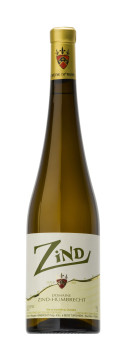
Technical presentation
| Bottling : | February 2017 |
|---|---|
| Acquired alcohol : | 13.0 ° |
| Residual sugar : | 5.3 g/l |
| Total acidity : | 3.7 g/l H2SO4 (5.7 g/l Tartrique) |
| pH : | 3.24 |
| Yield : | 72 hl/ha |
| Optimum tasting : | 2018/2030 |
| Average age of vines : | 26 years |
| Terroir : | Clos Windsbuhl |
| Sweetness index : | 1 |
| Soil : | Muschelkalk calcareous, South East facing |
Description of the wine Zind 2015
This wine is traditionally made from our blend of Chardonnay (2/3) and Auxerrois (1/3), both planted in 1989 in the Clos Windsbuhl vineyard. The cooler climate of the Windsbuhl, explained by its altitude and proximity of the forest, has preserved these grapes from the excessive heat waves of 2015. The Muschelkalk limestone also contains a significant amount of clay that keeps the soil cooler and improves its water retention capacity. A slightly later flowering also meant less coulure problems, so the vineyard produced a generous crop in 2015! The fermentation was slow, as usual with this clos, but the wine shows a perfect final balance.

Tasting notes
08/2017 : Pale yellow colour. Fresh fruity (citrus) nose with medium intensity for the moment as it clearly needs to open up. The palate is pure and clean, not marked by the long lees contact. The immediate sensation is of how much this wine is already enjoyable! No excess weight, nicely balanced and surprisingly ready. The limestone soil is obvious on the finish. The acidity and stony flavours are a characteristic of the vineyard, what is less common, is the amount of tannins (fruit tannins, no new oak there) that give a long finish and a dry firm structure.

The Clos Windsbuhl of Hunawihr
The altitude of the vineyard coupled with Hunawihr’s tardy climate means that the Clos Windsbuhl is often one of the last of our vineyards to be harvested. This explains the aromatic quality of the Clos’ wines and the consistent balance of acidity, a guarantee of good ageing. Although often harvested late, the Windsbuhl grapes are only rarely botryitized, doubtless due to the altitude of the vineyard, but nevertheless often reach high levels of maturity.